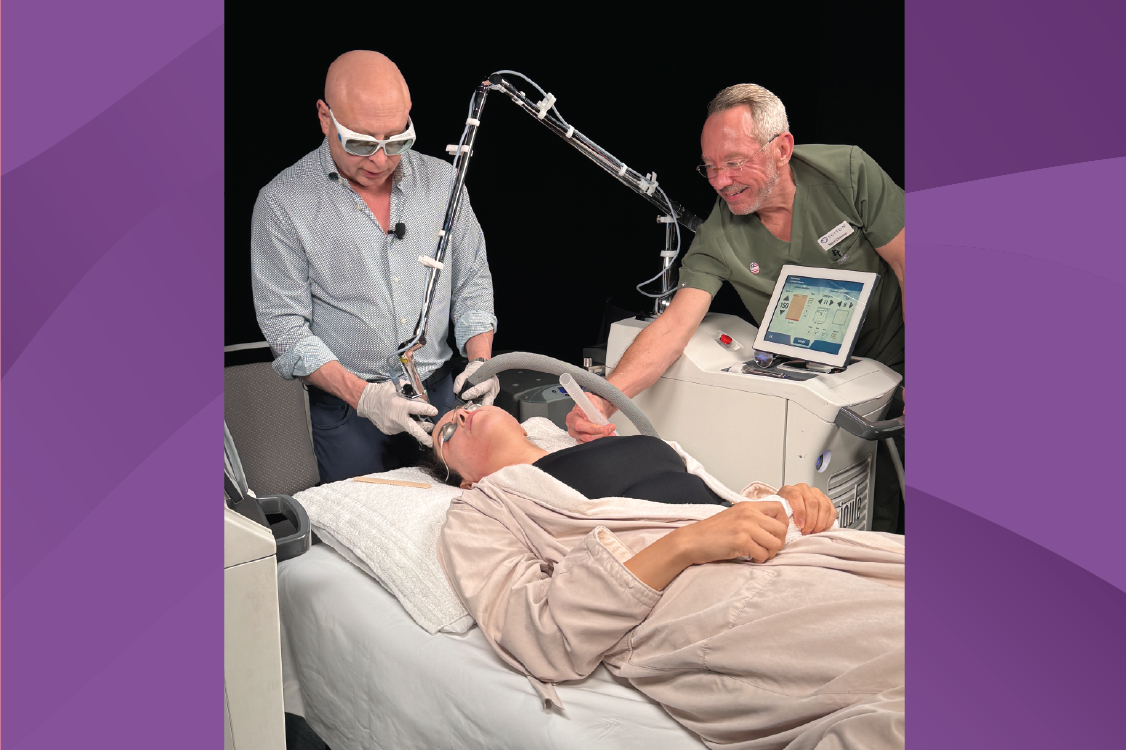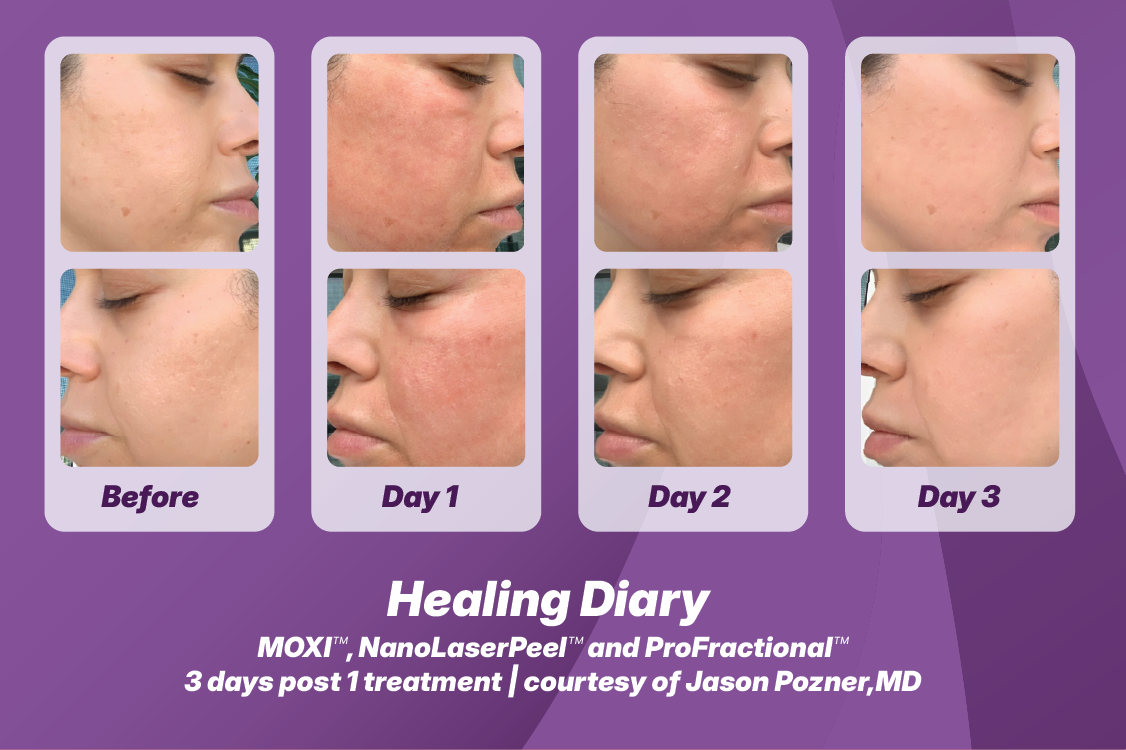Three lasers, a live audience of 300+, and a face that needed to stay cool under pressure. Here’s what really went down—and how my skin bounced back, looking better than before in just three days!
April 17, 2025—When a colleague at Sciton mentioned they were looking for a model to receive a live ScitonStaX™ treatment at our Skin CEO: Boosted event in Orlando—with Dr. Jason Pozner, no less—I said yes before I had time to talk myself out of it.
I’d been wanting to try StaX. I knew the results could be incredible, but I was still a little apprehensive about what to expect, especially since it involved full-field resurfacing and would take place in front of a live audience. But sometimes you’ve got to go all in.
I did it. My only regret? Not doing it sooner.
What is ScitonStaX?
ScitonStaX is Sciton’s exclusive approach to combination therapy—stacking complementary treatments to target multiple concerns in one session. Think of it as a custom recipe for radiant skin: you mix and match modalities to address the appearance of texture, pigment, pores, fine lines, acne scars, and more. It’s effective, efficient, and completely customizable based on skin type, goals, and downtime tolerance.
Sciton’s platforms are designed to be configurable, offering modular treatments that can be added and combined, each tailored to complement the others and enhance results. Dr. Rebecca Gelber, MD, explains in this webinar that the ability to customize a Sciton platform with multiple high-performance modules gives practices a clear competitive edge. You can start with the treatments that suit your current needs and expand over time, toggling between modalities to treat multiple concerns in a single visit.
That flexibility was on full display during the StaX demo. Robb Brindley, Sciton’s Executive Vice President of Sales and Marketing, walked the audience through how each delivery method targets a different layer of the skin to address multiple concerns in one session.
We start with MOXI to polish the skin, followed by a light full-field treatment using the NanoLaserPeel, and finish with ProFractional to target deeper areas of concern, explained Robb. Each modality plays a specific role, and when combined, they create a more comprehensive result than any single treatment alone. MOXI excels at skin polishing thanks to its unique absorption profile—something fractional ablative lasers alone can’t match. And when it comes to resurfacing and wrinkle reduction, having both fractional and full-field capabilities is essential.
This StaX combination delivers a true “wow” result in one session, with minimal downtime. As Robb put it, Sciton’s resurfacing tools remain some of the most effective in the industry—and when stacked strategically, they become even more powerful.
👀 Want to learn the art of stacking? Join us at an upcoming Skin CEO: Boosted event where top providers demo these treatments live.
Pre-treatment jitters + setup
Even though I’ve had HALO before, I was a little nervous the night before. This was my first time experiencing Sciton’s erbium full-field resurfacing—and my first time doing it on camera. I followed my pre-treatment instructions (numb for an hour, arrive ready) and headed to the treatment room, heart racing but ready.
A few colleagues surrounded me—some cheering me on, others prepping me for what was ahead. I washed off the numbing cream, slipped into a robe, and lay down on the treatment table. Showtime.

Photo caption: Dr. Jason Pozner, MD; Steve Clemmer, Sciton’s Senior Technical Laser Specialist; and Nancy Salim (me), Copywriter at Sciton and patient, during a live ScitonStaX treatment.
The treatment breakdown
Here’s how it went, step by step:
MOXI – 10 mJ / 10% density
MOXI was first. This non-ablative 1927 nm laser helps polish the skin, improve the appearance of tone and texture, and brighten the complexion. It was smooth sailing—I didn’t feel a thing.
NanoLaserPeel – 8 microns face / 4 microns neck
This gentle, full-field resurfacing treatment exfoliates the outer layers of skin for a brighter, more even complexion. Also very tolerable. When we say “comfortable” in our marketing, I now know we mean it (with topical numbing for most treatments).
ProFractional – 150 microns at 11%; 100 microns under eyes at 22% density; 150 coag; 2 passes
The final step, and the most intense but still very tolerable (delivered with a Zimmer chiller for added comfort). ProFractional targets deeper layers of skin for dramatic results on scarring, wrinkles, and texture. It had a little bite, especially around the eyes, but with the numbing, it was very manageable.
Video caption: ProFractional treatment by Dr. Jason Pozner, MD.
Post-treatment + downtime
Right after my StaX treatment, I applied a Velez mask, and it felt amazing. Possibly too amazing—I may have used two or three the same day (maybe, don’t do that. Over-masking can trap heat and potentially increase the risk of hyperpigmentation). I took Tylenol and headed back to the ballroom back to work. I didn’t want to miss the rest of the Skin CEO: Boosted sessions, especially The Laser Queen Presents: Lessons in the Light Lab with Dr. Dianne Quibell! By bedtime, the discomfort had passed.
That night, I applied Alastin’s skin regenerating nectar and their recovery balm and went to bed. I woke up in the middle of the night, and my skin felt tight and dry—the balm I’d applied had rubbed off—so I reapplied and went back to sleep. The next morning, I returned to work with no pain, just redness and tightness.
Healing timeline: Fully recovered in just 3 days
Day 1: Skin felt tight and dry. I kept up with Alastin’s Skin Nectar and Soothe + Protect Recovery Balm.
Day 2: Almost fully healed. Just a light sandpaper feel on the surface.
Day 3: Fully healed. I couldn’t believe it. Texture looked smoother, pores less visible, and the redness was fading fast.
What helped my skin bounce back so quickly? A combination of things.
Keeping my skin super moisturized with the recovery balm (I was told Vaseline would work, too) definitely helped. On Day 2, after washing my face in the shower, I could feel the dead skin gently sloughing off. No aggressive peeling—just a soft polish.
I also credit the synergy between ScitonStaX for speeding up my recovery—the treatments are designed to work together and complement one another. And of course, Dr. Pozner’s skills and expertise made all the difference. He’s a true artist.
It’s also worth noting that ProFractional, Sciton’s fractionated laser, plays a big role in minimizing downtime. By creating precise microchannels in the skin, rather than removing the entire surface, it jump-starts the skin’s natural healing process while leaving the surrounding tissue intact. This targeted approach promotes faster recovery and allows for impressive results without extended downtime.

The results
The scarring on my cheeks looked softened after just one treatment, only three days post-treatment. My skin tone looked more even, my pores smaller, and the most significant difference was the overall texture of my skin, which was noticeably smoother.
What surprised me the most was how fast I recovered—and how good my skin looked just days after. I expected more downtime. Instead, I was back at work and loving my skin.

Final thoughts: Would I do it again?
Absolutely. I’m a true believer in Sciton’s technology—and now I know just how customizable and powerful StaX can be. If you’re a provider wondering if patients will tolerate it or if it delivers fast results, the answer is yes to both. As a patient, I’m grateful to know there are real solutions for skin concerns like mine. With the right treatment, you really can feel good in your skin again.
I’m already planning my next round. Once you try ScitonStaX, there’s no going back!
Nancy Salim is a writer at Sciton, where she covers aesthetics, laser and light-based innovations, and the evolving world of skin technology. This is her personal account of receiving a ScitonStaX™ treatment.

